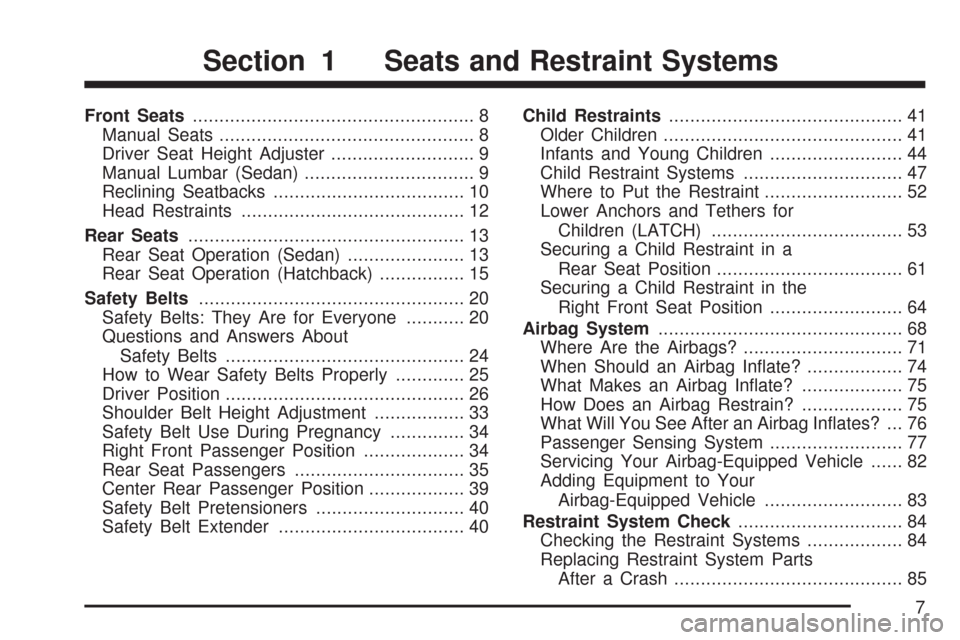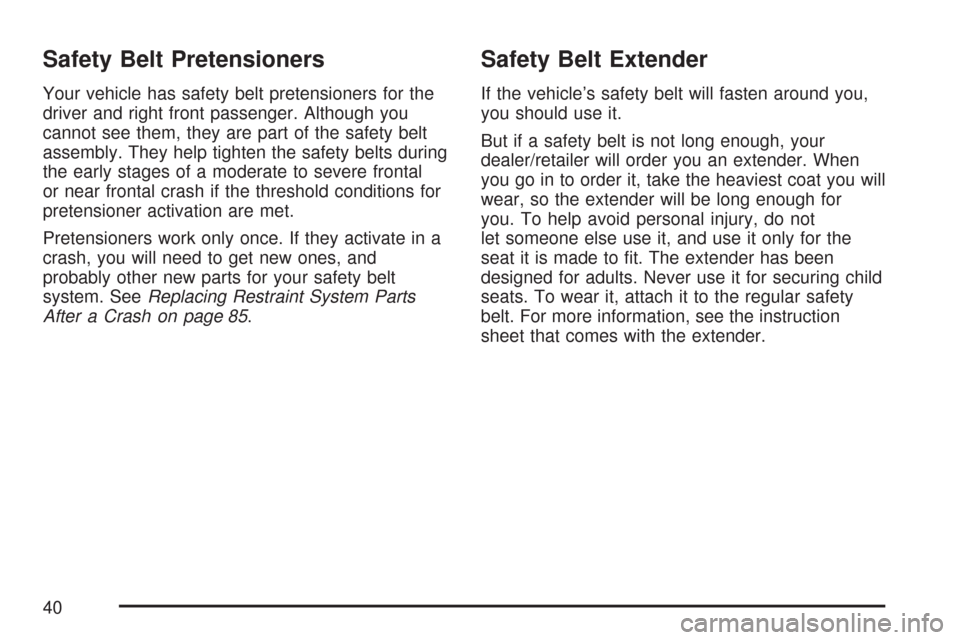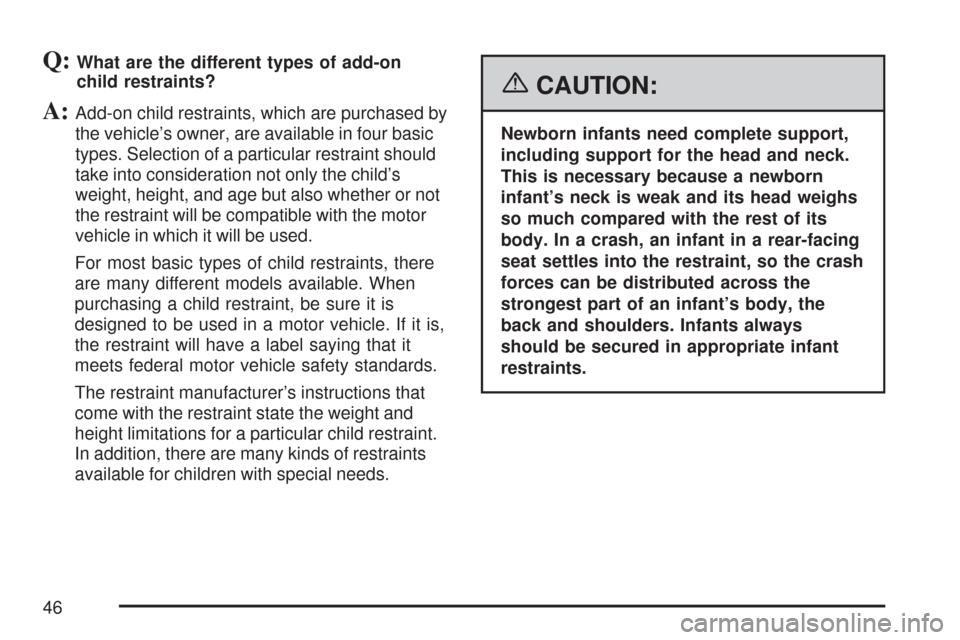Page 1 of 436

Seats and Restraint Systems
........................ 7
Front Seats
.............................................. 8
Rear Seats
............................................. 13
Safety Belts
............................................ 20
Child Restraints
...................................... 41
Airbag System
........................................ 68
Restraint System Check
......................... 84
Features and Controls
................................. 87
Keys
....................................................... 88
Doors and Locks
.................................... 94
Windows
............................................... 101
Theft-Deterrent Systems
....................... 103
Starting and Operating Your Vehicle
..... 107
Mirrors
.................................................. 124
Storage Areas
...................................... 126
Sunroof
................................................ 128Instrument Panel
........................................ 129
Instrument Panel Overview
................... 132
Climate Controls
................................... 150
Warning Lights, Gages,
and Indicators
.................................... 156
Secondary Information Center (SIC)
...... 174
Audio System(s)
................................... 186
Driving Your Vehicle
.................................. 219
Your Driving, the Road,
and Your Vehicle
.............................. 220
Towing
................................................. 258
Service and Appearance Care
................... 261
Service
................................................. 264
Fuel
...................................................... 266
Checking Things Under the Hood
......... 273
Headlamp Aiming
................................. 309
2007 Chevrolet Aveo Owner ManualM
1
Page 7 of 436

Front Seats..................................................... 8
Manual Seats................................................ 8
Driver Seat Height Adjuster........................... 9
Manual Lumbar (Sedan)................................ 9
Reclining Seatbacks.................................... 10
Head Restraints.......................................... 12
Rear Seats.................................................... 13
Rear Seat Operation (Sedan)...................... 13
Rear Seat Operation (Hatchback)................ 15
Safety Belts.................................................. 20
Safety Belts: They Are for Everyone........... 20
Questions and Answers About
Safety Belts............................................. 24
How to Wear Safety Belts Properly............. 25
Driver Position............................................. 26
Shoulder Belt Height Adjustment................. 33
Safety Belt Use During Pregnancy.............. 34
Right Front Passenger Position................... 34
Rear Seat Passengers................................ 35
Center Rear Passenger Position.................. 39
Safety Belt Pretensioners............................ 40
Safety Belt Extender................................... 40Child Restraints............................................ 41
Older Children............................................. 41
Infants and Young Children......................... 44
Child Restraint Systems.............................. 47
Where to Put the Restraint.......................... 52
Lower Anchors and Tethers for
Children (LATCH).................................... 53
Securing a Child Restraint in a
Rear Seat Position................................... 61
Securing a Child Restraint in the
Right Front Seat Position......................... 64
Airbag System.............................................. 68
Where Are the Airbags?.............................. 71
When Should an Airbag Inflate?.................. 74
What Makes an Airbag Inflate?................... 75
How Does an Airbag Restrain?................... 75
What Will You See After an Airbag Inflates? ... 76
Passenger Sensing System......................... 77
Servicing Your Airbag-Equipped Vehicle...... 82
Adding Equipment to Your
Airbag-Equipped Vehicle.......................... 83
Restraint System Check............................... 84
Checking the Restraint Systems.................. 84
Replacing Restraint System Parts
After a Crash........................................... 85
Section 1 Seats and Restraint Systems
7
Page 40 of 436

Safety Belt Pretensioners
Your vehicle has safety belt pretensioners for the
driver and right front passenger. Although you
cannot see them, they are part of the safety belt
assembly. They help tighten the safety belts during
the early stages of a moderate to severe frontal
or near frontal crash if the threshold conditions for
pretensioner activation are met.
Pretensioners work only once. If they activate in a
crash, you will need to get new ones, and
probably other new parts for your safety belt
system. SeeReplacing Restraint System Parts
After a Crash on page 85.
Safety Belt Extender
If the vehicle’s safety belt will fasten around you,
you should use it.
But if a safety belt is not long enough, your
dealer/retailer will order you an extender. When
you go in to order it, take the heaviest coat you will
wear, so the extender will be long enough for
you. To help avoid personal injury, do not
let someone else use it, and use it only for the
seat it is made to fit. The extender has been
designed for adults. Never use it for securing child
seats. To wear it, attach it to the regular safety
belt. For more information, see the instruction
sheet that comes with the extender.
40
Page 41 of 436
Child Restraints
Older Children
Older children who have outgrown booster seats
should wear the vehicle’s safety belts.
Q:What is the proper way to wear safety
belts?
A:If possible, an older child should wear a
lap-shoulder belt and get the additional
restraint a shoulder belt can provide. The
shoulder belt should not cross the face
or neck. The lap belt should fit snugly below
the hips, just touching the top of the thighs. It
should never be worn over the abdomen,
which could cause severe or even fatal internal
injuries in a crash.
According to accident statistics, children are safer
when properly restrained in the rear seating
positions than in the front seating positions.
In a crash, children who are not buckled up can
strike other people who are buckled up, or can be
thrown out of the vehicle. Older children need
to use safety belts properly.
41
Page 42 of 436
{CAUTION:
Never do this.
Here two children are wearing the same
belt. The belt cannot properly spread the
impact forces. In a crash, the two children
can be crushed together and seriously
injured. A belt must be used by only one
person at a time.
Q:What if a child is wearing a lap-shoulder
belt, but the child is so small that the
shoulder belt is very close to the child’s
face or neck?
A:If the child is sitting in a seat next to a
window, move the child toward the center of
the vehicle. If the child is sitting in the
center rear seat passenger position, move the
child toward the safety belt buckle. In either
case, be sure that the shoulder belt still
is on the child’s shoulder, so that in a crash
the child’s upper body would have the restraint
that belts provide.
42
Page 43 of 436
{CAUTION:
Never do this.
Here a child is sitting in a seat that has a
lap-shoulder belt, but the shoulder part is
behind the child. If the child wears the
belt in this way, in a crash the child might
slide under the belt. The belt’s force
would then be applied right on the child’s
abdomen. That could cause serious or
fatal injuries.
Wherever the child sits, the lap portion of the belt
should be worn low and snug on the hips, just
touching the child’s thighs. This applies belt force
to the child’s pelvic bones in a crash.
43
Page 46 of 436

Q:What are the different types of add-on
child restraints?
A:Add-on child restraints, which are purchased by
the vehicle’s owner, are available in four basic
types. Selection of a particular restraint should
take into consideration not only the child’s
weight, height, and age but also whether or not
the restraint will be compatible with the motor
vehicle in which it will be used.
For most basic types of child restraints, there
are many different models available. When
purchasing a child restraint, be sure it is
designed to be used in a motor vehicle. If it is,
the restraint will have a label saying that it
meets federal motor vehicle safety standards.
The restraint manufacturer’s instructions that
come with the restraint state the weight and
height limitations for a particular child restraint.
In addition, there are many kinds of restraints
available for children with special needs.
{CAUTION:
Newborn infants need complete support,
including support for the head and neck.
This is necessary because a newborn
infant’s neck is weak and its head weighs
so much compared with the rest of its
body. In a crash, an infant in a rear-facing
seat settles into the restraint, so the crash
forces can be distributed across the
strongest part of an infant’s body, the
back and shoulders. Infants always
should be secured in appropriate infant
restraints.
46
Page 48 of 436
A rear-facing infant seat (B) provides restraint with
the seating surface against the back of the
infant. The harness system holds the infant in
place and, in a crash, acts to keep the infant
positioned in the restraint.A forward-facing child seat (C-E) provides restraint
for the child’s body with the harness and also
sometimes with surfaces such as T-shaped
or shelf-like shields.
48